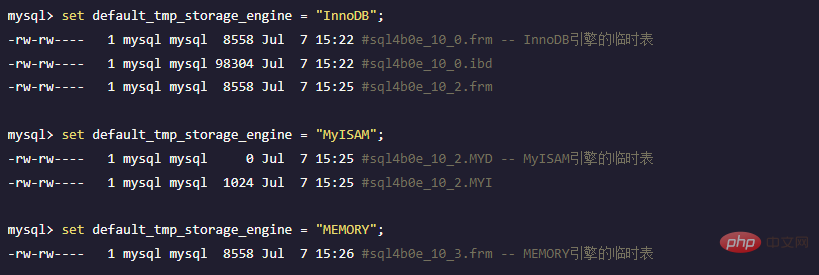When to use temporary table in mysql
When using temporary tables in mysql: 1. When using the TEMPTABLE algorithm or the view in the UNION query; 2. When using the DISTINCT query and adding ORDER BY; 3. When using "SQL_SMALL_RESULT" in SQL " option; 4. When using the subquery in FROM, etc.

The operating environment of this tutorial: windows10 system, mysql8.0.22 version, Dell G3 computer.
When to use temporary tables in mysql
MySQL will create temporary tables in the following situations:
1. UNION query;
2. Use the TEMPTABLE algorithm or the view in the UNION query;
3. When the clauses of ORDER BY and GROUP BY are different;
4. In table connection, ORDER The column of BY is not in the driver table;
5. When querying DISTINCT and adding ORDER BY;
6. When the SQL_SMALL_RESULT option is used in SQL;
7. Subquery in FROM;
8, subquery or table created during semi-join;
EXPLAIN Check the Extra column of the execution plan result. If it contains Using Temporary, it means it will be used. Temporary tables.
Of course, if the amount of data that needs to be stored in the temporary table exceeds the upper limit (tmp-table-size or max-heap-table-size, whichever is greater), then you need to generate a disk-based Temporary table.
In the following situations, a disk temporary table will be created:
1. The data table contains BLOB/TEXT columns;
2. In the columns of GROUP BY or DSTINCT, there are character type columns exceeding 512 characters (or binary type columns exceeding 512 bytes, before 5.6.15, only whether it exceeds 512 bytes);
3. In SELECT , UNION, UNION ALL queries, there are columns with a maximum length exceeding 512 (512 characters for string types, 512 bytes for binary types);
4. Execute SHOW COLUMNS/FIELDS and DESCRIBE Wait for SQL commands because their execution results use the BLOB column type.
Starting from 5.7.5, there is a new system option internal_tmp_disk_storage_engine that can define the engine type of the disk temporary table as InnoDB. Before this, only MyISAM could be used. The new system option default_tmp_storage_engine added after 5.6.3 controls the engine type of the temporary table created by CREATE TEMPORARY TABLE. In the past, the default was MEMORY. Do not confuse the two.
See the following example:

Recommended learning: mysql video tutorial
The above is the detailed content of When to use temporary table in mysql. For more information, please follow other related articles on the PHP Chinese website!

Hot AI Tools

Undresser.AI Undress
AI-powered app for creating realistic nude photos

AI Clothes Remover
Online AI tool for removing clothes from photos.

Undress AI Tool
Undress images for free

Clothoff.io
AI clothes remover

Video Face Swap
Swap faces in any video effortlessly with our completely free AI face swap tool!

Hot Article

Hot Tools

Notepad++7.3.1
Easy-to-use and free code editor

SublimeText3 Chinese version
Chinese version, very easy to use

Zend Studio 13.0.1
Powerful PHP integrated development environment

Dreamweaver CS6
Visual web development tools

SublimeText3 Mac version
God-level code editing software (SublimeText3)

Hot Topics
 1664
1664
 14
14
 1423
1423
 52
52
 1321
1321
 25
25
 1269
1269
 29
29
 1249
1249
 24
24
 Laravel Introduction Example
Apr 18, 2025 pm 12:45 PM
Laravel Introduction Example
Apr 18, 2025 pm 12:45 PM
Laravel is a PHP framework for easy building of web applications. It provides a range of powerful features including: Installation: Install the Laravel CLI globally with Composer and create applications in the project directory. Routing: Define the relationship between the URL and the handler in routes/web.php. View: Create a view in resources/views to render the application's interface. Database Integration: Provides out-of-the-box integration with databases such as MySQL and uses migration to create and modify tables. Model and Controller: The model represents the database entity and the controller processes HTTP requests.
 MySQL and phpMyAdmin: Core Features and Functions
Apr 22, 2025 am 12:12 AM
MySQL and phpMyAdmin: Core Features and Functions
Apr 22, 2025 am 12:12 AM
MySQL and phpMyAdmin are powerful database management tools. 1) MySQL is used to create databases and tables, and to execute DML and SQL queries. 2) phpMyAdmin provides an intuitive interface for database management, table structure management, data operations and user permission management.
 MySQL vs. Other Programming Languages: A Comparison
Apr 19, 2025 am 12:22 AM
MySQL vs. Other Programming Languages: A Comparison
Apr 19, 2025 am 12:22 AM
Compared with other programming languages, MySQL is mainly used to store and manage data, while other languages such as Python, Java, and C are used for logical processing and application development. MySQL is known for its high performance, scalability and cross-platform support, suitable for data management needs, while other languages have advantages in their respective fields such as data analytics, enterprise applications, and system programming.
 Solve database connection problem: a practical case of using minii/db library
Apr 18, 2025 am 07:09 AM
Solve database connection problem: a practical case of using minii/db library
Apr 18, 2025 am 07:09 AM
I encountered a tricky problem when developing a small application: the need to quickly integrate a lightweight database operation library. After trying multiple libraries, I found that they either have too much functionality or are not very compatible. Eventually, I found minii/db, a simplified version based on Yii2 that solved my problem perfectly.
 Laravel framework installation method
Apr 18, 2025 pm 12:54 PM
Laravel framework installation method
Apr 18, 2025 pm 12:54 PM
Article summary: This article provides detailed step-by-step instructions to guide readers on how to easily install the Laravel framework. Laravel is a powerful PHP framework that speeds up the development process of web applications. This tutorial covers the installation process from system requirements to configuring databases and setting up routing. By following these steps, readers can quickly and efficiently lay a solid foundation for their Laravel project.
 Solve MySQL mode problem: The experience of using the TheliaMySQLModesChecker module
Apr 18, 2025 am 08:42 AM
Solve MySQL mode problem: The experience of using the TheliaMySQLModesChecker module
Apr 18, 2025 am 08:42 AM
When developing an e-commerce website using Thelia, I encountered a tricky problem: MySQL mode is not set properly, causing some features to not function properly. After some exploration, I found a module called TheliaMySQLModesChecker, which is able to automatically fix the MySQL pattern required by Thelia, completely solving my troubles.
 MySQL: Structured Data and Relational Databases
Apr 18, 2025 am 12:22 AM
MySQL: Structured Data and Relational Databases
Apr 18, 2025 am 12:22 AM
MySQL efficiently manages structured data through table structure and SQL query, and implements inter-table relationships through foreign keys. 1. Define the data format and type when creating a table. 2. Use foreign keys to establish relationships between tables. 3. Improve performance through indexing and query optimization. 4. Regularly backup and monitor databases to ensure data security and performance optimization.
 MySQL: Key Features and Capabilities Explained
Apr 18, 2025 am 12:17 AM
MySQL: Key Features and Capabilities Explained
Apr 18, 2025 am 12:17 AM
MySQL is an open source relational database management system that is widely used in Web development. Its key features include: 1. Supports multiple storage engines, such as InnoDB and MyISAM, suitable for different scenarios; 2. Provides master-slave replication functions to facilitate load balancing and data backup; 3. Improve query efficiency through query optimization and index use.




